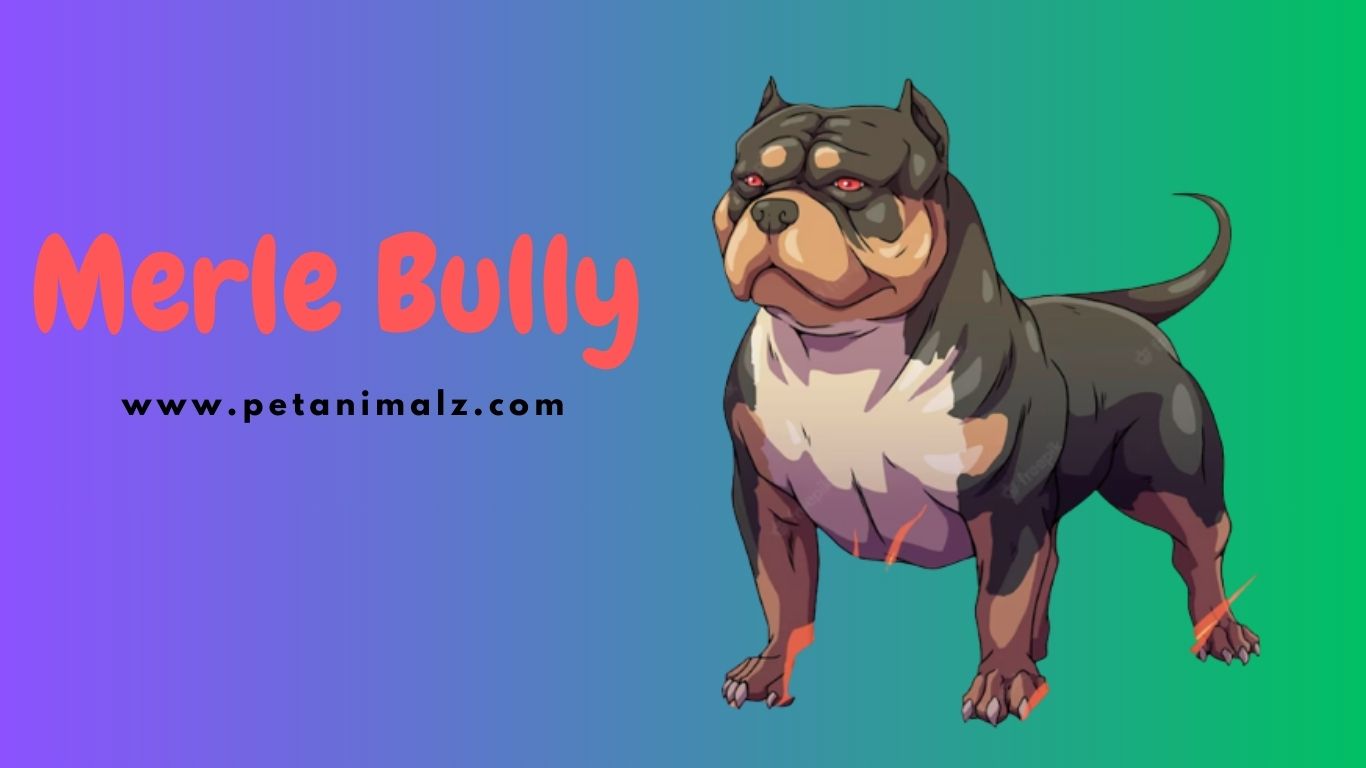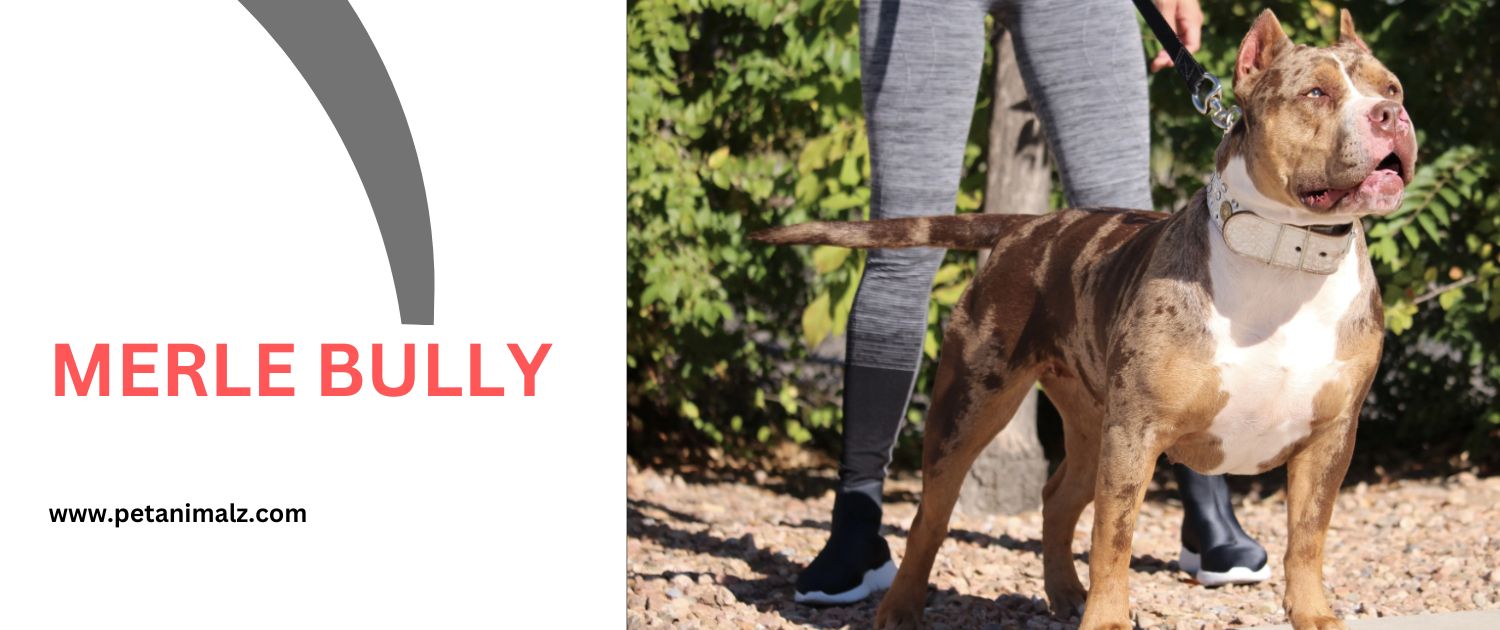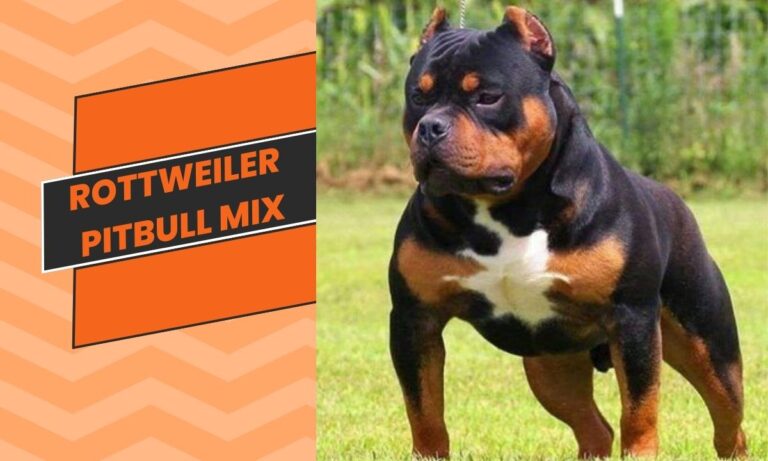Merle Bully – The Unique Blend of Color and Character
Introduction:
This article provides the information about mesmerizing world of the Merle Bully, a distinctive breed that stands out with its unique coat patterns and loyal nature. This guide aims to shed light on the origins, characteristics, and all the nuances that make this American Bully variant so special.

History and Origin of the Merle Bully:
- The Blend: The Merle Bully is a result of the intricate blend between the American Pit Bull Terrier and the American Bulldog. This combination not only gives the breed its distinctive appearance but also its commendable temperament.
- Popularity and Controversies: Over the years, the Merle Bully has seen a significant rise in popularity. However, with fame comes scrutiny. The breed has been at the center of numerous debates and controversies, primarily revolving around its breeding practices and potential health concerns. Despite the challenges, the Merle Bully continues to captivate hearts with its unique appearance and unwavering loyalty.
Merle Bullies Are A Unique and Special Breed of Dog
Absolutely! Merle Bullies are indeed a unique and special breed of dog. Their distinctive coat patterns and colors make them stand out in the canine world. Here’s a brief overview of what makes them so special:
- Unique Coat Patterns
Merle Bullies have a coat pattern characterized by patches of hair with diluted pigment (color). This results in a mottled or marbled appearance, which can vary greatly from one dog to another. No two Merle Bullies have the exact same coat pattern, making each one truly unique.
- Eye Color Variations
Merles commonly have blue eyes, but they can also have one blue and one brown eye, or even two brown eyes. This variation in eye color adds to their distinctive appearance.
- Strong Genetic Traits
The merle gene is dominant, which means that a Merle Bully will have inherited the gene from one of its parents. This strong genetic trait ensures the continuation of the unique merle pattern in offspring.
- Loyal and Loving Temperament
Beyond their physical appearance, Merle Bullies are known for their loyal and loving nature. They are often described as being great family dogs, forming strong bonds with their human companions.
- Health Considerations
While the merle pattern is undeniably beautiful, it’s essential for potential owners and breeders to be aware of the health issues associated with the merle gene, especially when breeding two merle dogs together. Responsible breeding practices are crucial to ensure the health and well-being of the dogs.
- A Breed Surrounded by Controversy
The breeding of Merle Bullies has been a topic of debate and controversy in the canine world. Some argue against breeding for the merle pattern due to potential health risks, while others believe that with responsible breeding practices, these risks can be minimized.
In conclusion, Merle Bullies are a testament to the diverse and fascinating world of canine genetics. Their unique appearance combined with their loving nature makes them a favorite for many dog enthusiasts. However, as with any breed, it’s essential to approach ownership and breeding with knowledge and responsibility.
Double Merles American Bully
Double Merles, often referred to as “lethal whites” in some circles, are the result of breeding two merle-coated dogs together. In the world of American Bullies, and many other breeds, this practice is controversial due to the health issues it can cause. Here’s a deeper dive into the topic:
What is a Double Merle?
A double merle inherits the merle gene from both parents. While the merle gene creates the unique and beautiful patterns that many people admire, inheriting two copies of this gene can lead to significant health issues.
Health Concerns:
- Vision Issues: Double merles often have eye abnormalities, which can range from small eyes (microphthalmia) to missing eyes (anophthalmia). They can also have irregularly shaped pupils (colobomas) or a detached retina.
- Hearing Issues: Many double merles are deaf in one or both ears. This is because the inner ear lacks pigment, which is necessary for the hair cells in the ear to function correctly.
- Skin Sensitivity: Due to the lack of pigment, double merles can be more susceptible to sunburn.
Ethical Concerns:
Breeding two merles together is generally discouraged because of the 25% chance that the offspring will be a double merle, leading to the potential health issues mentioned above. Many breeders and canine organizations consider it unethical to breed in a way that increases the risk of producing puppies with predictable health problems.
Identification:
Double merles are often predominantly white with some patches of merle. Their unique appearance, combined with the health issues they often face, makes them easily identifiable.
Ownership:
Owning a double merle requires special considerations:
- Training: Due to potential hearing or vision impairments, double merles might need specialized training techniques.
- Protection: They may require sunblock or protective clothing when outside to prevent sunburn.
- Regular Vet Check-ups: Regular check-ups can help catch and address any health issues early on.
While Double Merle American Bullies can be loving and loyal companions, it’s crucial for potential owners to be aware of the challenges they might face. Breeding practices that produce double merles are controversial, and potential breeders should approach the decision with a deep understanding of the ethical and health implications.
Merle Bully: The Results of Inbreeding
The Merle Bully is a visually striking variant of the American Bully, known for its unique coat pattern. However, the merle gene and its association with inbreeding is a topic of debate and concern in the canine world. Let’s delve into the relationship between the merle pattern in American Bullies and inbreeding.
The Merle Gene:
The merle gene creates mottled patches of color in what would otherwise be a solid-colored coat. A dog that inherits the merle gene from one parent will have a merle coat. However, if a dog inherits the merle gene from both parents (making it a double merle), it can lead to significant health issues.
Inbreeding and Its Consequences:
Inbreeding refers to the mating of closely related individuals, often to maintain or enhance specific desired traits in offspring. While it can solidify certain characteristics, it also has the potential to amplify genetic defects.
- Health Issues: Inbreeding can increase the risk of inherited health problems. In the case of merle-to-merle breeding, there’s a 25% chance the offspring will be double merle, which can lead to deafness, blindness, and other health concerns.
- Limited Genetic Diversity: Over time, inbreeding can reduce genetic diversity, making the breed more susceptible to diseases and reducing overall vitality.
The Merle Controversy:
- Breeding Ethics: Many breeders and canine organizations discourage merle-to-merle breeding due to the predictable health risks for the offspring. However, some breeders might still engage in this practice to produce the visually appealing merle pattern, often at the expense of the dog’s health.
- Misidentification: Not all merle-patterned dogs are the result of inbreeding. It’s essential to differentiate between responsible breeding practices that produce merle-patterned dogs and inbreeding that might produce double merles.
Responsible Breeding:
To ensure the health and well-being of Merle Bullies:
- Genetic Testing: Breeders should conduct genetic tests to understand the genes their breeding pairs carry. This can help avoid unintentional merle-to-merle breeding.
- Avoid Merle-to-Merle Breeding: By avoiding the breeding of two merle-patterned dogs, breeders can significantly reduce the risk of producing double merle offspring.
- Educate Potential Owners: Breeders should educate potential owners about the merle gene, its associated health risks, and the importance of responsible breeding.
Merle Coat Bully vs. Other Bully
The Merle Bully stands out in the canine world due to its distinctive coat pattern. However, when compared to other types of American Bullies, there are distinct differences and similarities. Let’s delve into a comparison between the Merle Coat Bully and other variants of the American Bully.
Merle Coat Bully:
Appearance:
- Coat Pattern: The merle gene creates a mottled or marbled coat pattern, which can vary greatly from one dog to another. This pattern is characterized by patches of diluted pigment on a solid-colored coat.
- Eye Color: Merle Bullies can have unique eye colors, including blue, green, or even one blue and one brown eye.
Health Concerns:
- Breeding two merle-patterned dogs can lead to double merles, which have a high risk of health issues like deafness and blindness.
Popularity:
- Due to their unique appearance, Merle Bullies have gained popularity. However, they’re also surrounded by controversy due to the associated health risks and breeding ethics.
Other Bullies:
Appearance:
- Coat Colors: Other American Bullies come in a variety of solid colors and patterns, including brindle, fawn, black, blue, and more. They don’t have the mottled appearance of the merle.
- Body Structure: While the coat pattern is a distinguishing factor for merle bullies, the body structure, muscle mass, and overall build are consistent with other American Bullies.
Health Concerns:
- Non-merle American Bullies generally don’t have the specific health concerns associated with the merle gene. However, like all breeds, they can have breed-specific health issues.
Popularity:
- The American Bully, in general, is a popular breed known for its loyalty, intelligence, and protective nature.
Key Differences:
- Coat Pattern: The most obvious difference is the coat pattern. Merle Bullies have a distinctive mottled appearance, while other bullies have solid or different patterns.
- Health Concerns: Merle Bullies have potential health risks associated with the merle gene, especially if bred with another merle.
- Breeding Ethics: The breeding of Merle Bullies is a topic of debate due to the potential health risks for the offspring.
Characteristics and Features
Merle Coat Pattern:
- The Science Behind the Merle Gene Mutation: The merle pattern is a result of a specific gene mutation that affects the distribution of melanin, leading to the unique coat patterns we see.
- Different Colors and Variations: The Merle Bully can exhibit a range of colors including:
- Black
- Blue
- Red
- Brindle
Dog Breeds with Merle Coats:
- The merle pattern isn’t exclusive to the American Bully. Other breeds showcasing this pattern include:
- Australian Shepherd
- Shetland Sheepdog
- Collies
- Border Collie
Characteristics of Merle American Bullies:
- Coat Patterns and Colors: The distinct patterns range from large blotches to speckled appearances.
- Eye Colors and Variations: From striking blue to heterochromia (two different colored eyes), the variations are captivating.
- Size and Temperament: These dogs are medium-sized with a temperament that’s both loyal and protective.
Types of American Merle Bullies:
- By Breeding:
- Standard
- Designer
- Hybrid
- By Coat Color:
- Red Merle
- Blue Merle
- Cryptic Merle
Health and Comparisons
Health Concerns and Conditions:
- Risks of Breeding Double Merles: Breeding two merle dogs can lead to severe health issues in the offspring.
- Common Health Issues: These include:
- Deafness
- Blindness
Merle Bully vs. Other Breeds:
- Comparing the Merle Bully with:
- Catahoula Leopard Dog
- American Staffordshire Terriers
- Pit Bulls
Ownership Insights
Pros and Cons of Owning a Merle Bully:
- Benefits:
- Loyalty
- Companionship
- Potential Challenges:
- Health concerns
- Breeding ethics
FAQs
-
Is it safe to own a merle dog?
-
- While merle dogs are generally safe to own, potential owners should be aware of the health risks associated with the breed.
-
How much grooming does a merle dog require?
-
- Regular grooming is essential to keep their coat in top condition.
-
What are the health risks associated with double merles?
-
- Breeding two merle dogs can lead to offspring with severe health issues like deafness and blindness.
-
What is the rarest color merle bully?
-
- The two most commonly seen types of merle are blue merles and red merles. Blue merles are, in fact, grey, appearing like a tri-color dog but with patches of the black appearing ‘faded’ or grey. A red merle will have faded patches of red and often looks more mottled than the blue merle. While all breeds with the merle coat pattern produce blue merles, only certain breeds produce red merles. The strength of the other colors in the dog’s coat can vary, with some merles appearing to have extremely pale coloring all over, while others can have quite strong patches of color.
-
What diet is best for a merle American bully?
-
- The article does not specify a particular diet for merle American bullies. However, like all dogs, a balanced diet that meets their nutritional needs is essential. It’s always best to consult with a veterinarian or canine nutritionist for specific dietary recommendations.
-
Why can’t you breed a merle to a merle bully?
-
- Breeding two merle dogs together can result in double merles or lethal whites, which have a high chance of being deaf, blind, or both due to the lack of pigment. Double merles are predominantly white with merle patches. The deliberate breeding of double merles causes controversy in the canine world, with certain official bodies discouraging the practice. Breeding two merles together increases the risk of producing puppies with health issues and deformities.
-
Is merle a strong gene?
-
- The merle gene is usually dominant. A merle dog will have inherited the gene from one of its parents. A dog with a merle coat will have the genotype Mm, meaning it has inherited one merle gene and one non-merle gene. However, a non-merle dog (unless a cryptic) will have inherited no merle gene.
-
What problems do merle bullies have?
- Merle American Bullies are prone to eye and ear abnormalities. They can suffer from partial to total deafness and poor eyesight due to intraocular pressure, both of which are associated with the lack of pigment. Hearing loss is attributed to the absence of pigment in the inner ear hairs. Limited visibility or eyesight issues come from visibly less pigment in the eye. The MM type is also associated with abnormalities of the skeletal system, cardiac (heart), and reproductive systems. Double merles, in particular, have a very high chance of being deaf, blind, or both because they lack pigment where it would normally be.
Conclusion:
Reflecting on the Merle Bully, it’s evident that while they are a breed of unique charm, potential owners should make informed decisions, considering both the joys and challenges of ownership.




